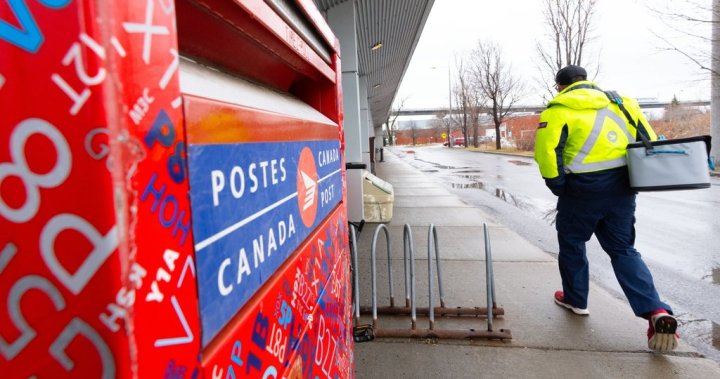A looming Canada Post strike is just one day away, with 55,000 postal workers in a strike position as of Friday and fuelling concerns about mail grinding to a halt.
Canada Post said on Monday it was notified by the Canadian Union of Postal Workers (CUPW) that employees for both urban and RSMC (rural and suburban mail carriers) bargaining units had issued strike notices.
Operations are expected to continue as usual until then, but the Crown corporation warned a labour disruption would affect millions of Canadians and businesses that rely on the postal service.
The corporation presented new offers to the union on Wednesday. CUPW says it is reviewing the offer and would provide an update once it had completed its analysis.
A spokesperson for Canada Post said it had denied the union’s request to take two weeks to consider the offer.
But as the strike date continues, here’s a look at some key numbers behind the ongoing negotiations and the financial issues facing Canada Post.
Where Canada Post’s finances stand
Canada Post is facing what the Crown corporation has called “critical” budget shortfalls, with Robert Kaplan, the commissioner who conducted an industrial inquiry commission into negotiations, saying in his report last week that it is “effectively insolvent, or bankrupt.”
In its most recent financial report, Canada Post recorded a loss before tax of $748 million in 2023, a 26-per cent increase from the $548 million lost a year prior.
Those finances have been a key point the corporation has made throughout negotiations, with the company noting in its press release about receiving the strike notices that it has recorded more than $3 billion in losses before tax since 2018 and expects another significant loss for 2024.
Amid those challenges, the federal government provided a lifeline in early January with repayable funding of up to $1.034 billion available for Canada Post’s 2025-26 fiscal year.
Canada Post said the funding would allow operations to continue though it wouldn’t help structural issues.
Get breaking National news
For news impacting Canada and around the world, sign up for breaking news alerts delivered directly to you when they happen.
That funding came just two months after the Crown corporation reported a loss before tax of $315 million in its third quarter amid a decline in parcel revenue and volumes.
That quarter’s revenue saw parcels dip 5.8 per cent and volumes decline by six million pieces, or 9.6 per cent to the previous year.
CUPW has not denied the corporation is in financial difficulties, though says the report by Kaplan “categorically rejected” its ideas for service expansion as an “immediate solution to Canada Post’s financial issue.”
How the demands on Canada Post have grown
Letter delivery, a key element of Canada Post’s service, has dropped substantially over the years after hitting its historic high of about 5.5 billion in 2006.
Since then, the number of letter mail volumes have declined by 60 per cent with just 2.2 billion delivered in 2023, even though the number of addresses it serves continues to increase.
Nearly two decades ago, the Crown corporation delivered mail to about 14.3 million addresses, a number that’s jumped to 17.4 million in 2023.
“Postal services in advanced economies around the world are experiencing these same challenges as part of the rapid growth of ecommerce and digital transformation for consumers and businesses,” the corporation’s annual report reads.
Canada Post also notes that the surge in privately-owned delivery companies during the COVID-19 pandemic had a bigger impact, with its low-cost operations gaining “significant ground.”
The report says its estimated parcel share has “eroded” from 62 per cent prior to the pandemic, to just 29 per cent in 2023.
Amid this drop in delivery, Kaplan suggested in his report that a moratorium on community mailboxes —put in place in 2015 — should be lifted.
This shift on community mailboxes, as well as the suggestion to close post offices and end door-to-door delivery except for businesses, had the union saying the recommendations amounted to service cuts, contracting out and major rollbacks to provisions in their collective agreement.
How many workers — and weekend work?
Last year, during the strike, a negotiator for CUPW told Global News that one of the key issues was securing permanent jobs for its temporary workers.
Jim Gallant said of the 55,000 workers, just over 22,000 are either temporary or part-time.
He said they were not looking to end temporary work and said they recognize there would be an “odd day” that temporary workers or part-time is needed, but “it can’t be the majority.”
Canada Post wants a corps of part-time workers to be deployed on weekends in response to rising parcel demand which right now would require paying overtime, spokesperson Jon Hamilton told the Canadian Press.
The union, however, has backed a purely full-time model that would move existing employees onto some weekend shifts and backs new contracts for its 55,000 members.
But a recent offer by the Crown corporation presented on Wednesday instead proposed creating “stable and predictable part-time jobs for people who are looking for flexible work.”
© 2025 Global News, a division of Corus Entertainment Inc.
Canada Post by the numbers: Where things stand as strike looms


